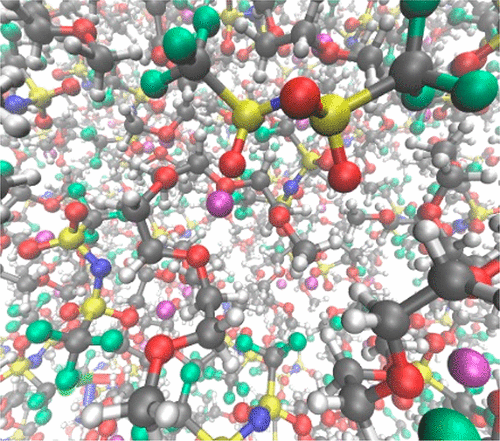当前位置:
X-MOL 学术
›
J. Phys. Chem. B
›
论文详情
Our official English website, www.x-mol.net, welcomes your
feedback! (Note: you will need to create a separate account there.)
Insight into the Solvation Structure of Tetraglyme-Based Electrolytes via First-Principles Molecular Dynamics Simulation
The Journal of Physical Chemistry B ( IF 2.8 ) Pub Date : 2018-10-17 , DOI: 10.1021/acs.jpcb.8b07098 Yang Sun 1 , Ikutaro Hamada 1, 2
The Journal of Physical Chemistry B ( IF 2.8 ) Pub Date : 2018-10-17 , DOI: 10.1021/acs.jpcb.8b07098 Yang Sun 1 , Ikutaro Hamada 1, 2
Affiliation

|
Glyme–lithium salt equimolar mixtures, as solvate ionic liquid electrolytes for rechargeable lithium secondary batteries, are of great interest, due to the desirable properties such as high oxidative stability, low vapor pressure, and nonflammability. However, the fundamental understanding of the solvation shell structure in glyme electrolytes has not been clearly established. Herein, we employ first-principles molecular dynamics (FPMD) simulation to study the lithium bis(trifluoromethylsulfonyl)-amide (LiTFSA) and tetraglyme (G4) electrolyte system. For the case of equimolar ratio, a positive correlation between the total coordination number of Li+ ions and the phase stability is clearly established. At the ground state of equimolar LiTFSA–G4 electrolyte, most of the Li+ ions are coordinated to four O atoms of a curled G4 molecule and one O atom of a TFSA– anion, equivalent to the second most stable contact ion pair in gas-phase cluster calculations. By contrast, Li+ ions prefer to be coordinated by two G4 molecules and not in direct contact with TFSA– anions at a low concentration of Li salt. The significantly increased probability of pairing between the Li–G4 complexes and TFSA– anions at the equimolar ratio could be highly relevant to its ionic-liquid-like properties.
中文翻译:

通过第一性原理分子动力学模拟洞察基于四氢邻苯二甲酸酯的电解质的溶剂化结构
甘氨酸锂盐等摩尔混合物,作为可再充电锂二次电池的溶剂化物离子液体电解质,由于其所需的特性,例如高氧化稳定性,低蒸气压和不燃性而备受关注。然而,尚未明确建立对甘醇二甲醚电解质中的溶剂化壳结构的基本理解。在这里,我们采用第一性原理分子动力学(FPMD)模拟来研究双(三氟甲基磺酰基)酰胺锂(LiTFSA)和四甘醇二甲醚(G4)电解质体系。对于等摩尔比,显然可以确定Li +离子的总配位数与相稳定性之间呈正相关。在等摩尔LiTFSA–G4电解质的基态下,大部分Li +离子配位到卷曲G4分子四个O原子和一个TFSA的一个O原子-阴离子,相当于在气相簇计算所述第二最稳定的接触离子对。相比之下,Li +离子更倾向于由两个G4分子配位,而不与TFSA (低浓度Li盐中的阴离子)直接接触。锂G4络合物和TFSA之间的配对的概率增加显著-阴离子在等摩尔比可能是它的离子液体样性质密切相关。
更新日期:2018-10-18
中文翻译:

通过第一性原理分子动力学模拟洞察基于四氢邻苯二甲酸酯的电解质的溶剂化结构
甘氨酸锂盐等摩尔混合物,作为可再充电锂二次电池的溶剂化物离子液体电解质,由于其所需的特性,例如高氧化稳定性,低蒸气压和不燃性而备受关注。然而,尚未明确建立对甘醇二甲醚电解质中的溶剂化壳结构的基本理解。在这里,我们采用第一性原理分子动力学(FPMD)模拟来研究双(三氟甲基磺酰基)酰胺锂(LiTFSA)和四甘醇二甲醚(G4)电解质体系。对于等摩尔比,显然可以确定Li +离子的总配位数与相稳定性之间呈正相关。在等摩尔LiTFSA–G4电解质的基态下,大部分Li +离子配位到卷曲G4分子四个O原子和一个TFSA的一个O原子-阴离子,相当于在气相簇计算所述第二最稳定的接触离子对。相比之下,Li +离子更倾向于由两个G4分子配位,而不与TFSA (低浓度Li盐中的阴离子)直接接触。锂G4络合物和TFSA之间的配对的概率增加显著-阴离子在等摩尔比可能是它的离子液体样性质密切相关。


















































 京公网安备 11010802027423号
京公网安备 11010802027423号